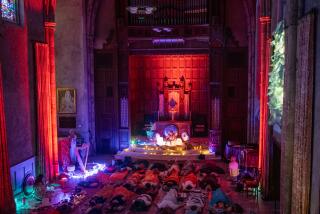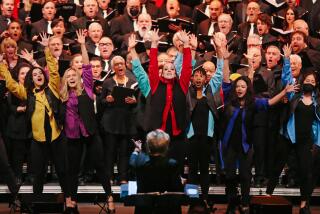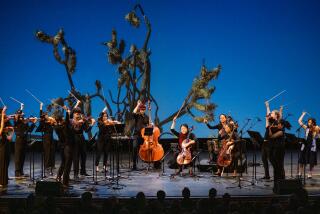Four Tones of Traditional Song : Early America Lives in the Sounds of Sacred Harp Music
- Share via
BOWDEN JUNCTION, Ga. — Inside the century-old white clapboard Holly Springs Primitive Baptist Church here deep in the backwoods, the fa-so-la singers of the Sacred Harp are singing James Denson’s 1844 Christmas anthem: “Strike, strike, strike their notes at our Redeemer’s birth....”
Seated on oak benches arranged in a hollow square, they are singing at the top of their lungs in four-part harmony, without musical accompaniment or an audience. Like their leader, each is holding a Sacred Harp song book in one hand and keeping time with the other.
After finishing the Christmas anthem, silver-haired Hugh McGraw, 58, the best-known fa-so-la singer in America, enters the hollow square and announces: “We will now sing one of our favorites, ‘Mt. Vernon, No. 110.’ ”
Time-Honored Tradition
Flipping through the pages of the Sacred Harp to song No. 110, they proceed to sing the 1799 hymn mourning the death of George Washington--twice--first in the time-honored tradition of fa-so-la, then word for word: “The father of his country dies. Where shall our nation turn its eyes? What help remains beneath the sky? Our friend, protector, strength and trust lies low and mould’ring in the dust.”
Sacred Harp, or fa-so-la, is church music sung with four notes. Brought to the New World by Pilgrims and Puritans from England, Scotland, Ireland and Wales, it cannot be compared to any other American music. Though little known, fa-so-la was sung at the birth of the nation, in the New England colonies and carried to the Southeastern states of Georgia and Alabama where it continues to thrive in rural communities.
In recent years, small groups of Sacred Harp singers have formed throughout the nation. But Georgia and Alabama are the heart of this unique folk music.
“It’s a dying art,” McGraw said. “At the turn of the century, there were thousands of Sacred Harp singers in Georgia alone. Today, there are, at the most, 4,000 to 5,000 fa-so-la singers left in America. We aim to preserve it.”
McGraw, manager of a trouser factory in Bremen, Ga., is credited with doing more than anyone to promote the survival of fa-so-la singing. He also serves as director of the Sacred Harp Publishing Co., headquartered in Bremen.
The nonprofit publishing company prints the original Sacred Harp song book, first published in Hamilton, Ga., in 1844 with songs compiled by Benjamin Franklin White. The 1987 edition is the eighth revised printing in 144 years. All editions have included this note: “The best collection of sacred songs, hymns, odes, and anthems ever offered the singing public for general use.” Since 1935, the hard-back song book has sold for $10. When first published in 1844, it sold for 40 cents.
McGraw knows all 547 songs in the book by heart. Contained in it are the only hymns sung by the fa-so-la singers, also known as the Sacred Harp singers or shape-note singers.
Each note in the song book is a different shape: fa is a triangle, la is a square, so is a circle and mi is a diamond.
During the late 1700s and early 1800s, there were 43 shape-note sacred music song books, all called Harp Hymnals. The Original Sacred Harp is the only one that survived.
Although the Original Sacred Harp song book was never adopted by any denomination, a few selections from it are found in church hymnals.
Among those in the Sacred Harp are: “Weeping Pilgrims,” “We’ll Soon Be There,” “The Last Words of Copernicus,” “Evening Shade,” “A Few More Years,” “Blooming Youth,” “Panting for Heaven,” “The Dying Boy” and “Bound for Canaan.”
Marathon Meetings
Sacred Harp singers participate in a number of all-day singings each year. They meet at a church on Saturday or Sunday, sing in the morning, break for lunch, and sing again in the afternoon.
Part of the tradition is “dinner on the ground,” for which participants are asked to bring covered dishes for a pot luck that always includes salads, fried chicken, country ham, black-eyed peas, okra, turnip greens and cakes.
The most well-attended recitals take place twice a year at the Holly Springs Primitive Baptist Church in Bowden Junction. As many as 1,000 singers from across the country turn out for these meetings in June and November.
Most of the all-day singings are at Primitive Baptist churches, because this small denomination holds services only once a month and sings the same old songs as the fa-so-la singers, also without accompaniment.
Wedding Celebration
It was at the Holly Springs Church on Nov. 25 that Myron House, 37, special collections librarian at West Georgia College in Carrollton, Ga., and Jan Rohde, 35, a medical records secretary, were married at a ceremony featuring 25 Sacred Harp singers, including the bride and groom.
“We have chosen Holly Springs Church because it is a gathering place for those who love Sacred Harp music,” wrote Jan Rohde in her wedding invitation.
Several singers at the wedding, including Richard DeLong, 25, a high school U.S. history teacher, and Bill Denney, 24, a student at West Georgia College, traced their ancestry to Sacred Harp singers who lived in the 1600s and 1700s.
“No other music takes you so far back in the history of America than fa-so-la singing. It upholds one of the oldest, purest musical traditions in this country,” House said.
More to Read
The biggest entertainment stories
Get our big stories about Hollywood, film, television, music, arts, culture and more right in your inbox as soon as they publish.
You may occasionally receive promotional content from the Los Angeles Times.










